Gujarat Board GSEB Solutions Class 7 Social Science Chapter 8 Medieval Architecture Textbook Exercise Important Questions and Answers, Notes Pdf.
Gujarat Board Textbook Solutions Class 7 Social Science Chapter 8 Medieval Architecture
GSEB Class 7 Social Science Medieval Architecture Textbook Questions and Answers
Give information about the places given below.
Question 1.
Somnath
Answer:

The Somnath Temple is located in Prabhas Pallan,near Veraval in Junagadh, Saurashtra, on the western coast of Gujarat. It is one of the twelve Jyotirlinga shrines of Lord Shiva. It was one of the most ancient, prosperous and important pilgrimages centres of Shaivism. Currently, only the site of the old temple is seen. The construction of the new temple was completed by 1951.
Question 2.
Dwarka
Answer:
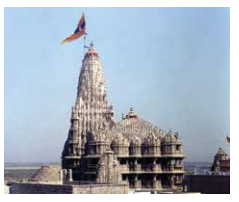
Dwarka is situated in Jamanagar district near the coast of Gujarat, on the northern banks of river Gomati. Constructed in the 13th century, the temple became part of the Char Dham (Handham) pilgrimage considered sacred by Hindus in India. It
consists of the four-armed deity of Lord Krishna within the Garbhagruh’ (inner sanctum) and a ‘Mahamandapa’ (big prayer hall).
One has to climb 80 steps to attain entry into this temple. Its Sikhar rises to six storeys. The Mandapa is a five-storeyed structure built on sixty pillars. The temple has rich carvings on its outer walls but the interiors are relatively plain. There
is a Matha’ of Shrimad Shankaracharya near the temple. Adj Shankaracharya, the 8th century reformer and philosopher, had set up ‘Mathas’ in all the four corners of India and the Dwarkadhish Temple is one of the Shardapith’ set up by him.
Question 3.
Rudra Mahalaya
Answer:

Rudra Mahalaya is a historical monument, located in Siddhpur in Patan district, on the banks of Saraswati River, in the northern Gujarat.
This magnificent temple, dedicated to Lord Shiva, called as the Rudra Mahalaya’ was constructed by Mulraj Solanki and then completed by Shri Siddhraj Jaysinh, the then ruler of Patan. The temple was an architectural wonder with a three-storeyed ‘shikhara’, 1600 pillars, 12 entrance doors, central ‘mandapa’ and porches on the east, north and south and sanctum in the west.
Around the temple, there were 11 shrines of Rudra. The eastern gate was adorned with beautifully carved ‘Taran’, with a flight of steps leading to the Saraswati River. The ornamentation of the temple was exuberant as shown by the elaborate and detailed carvings of the pillars and the beautiful Toran, which are the only remains of the temple today.
Question 4.
Sidi Sayyed Jail
Answer:
The Sidi Saiyyed Mosque is one of the most famous mosques of Ahmedabad, located near Lai Darwaja. It was built by Sidi Saeed or Sidi Saiyyed, a general in the army of the last Sultan Shams-ud-Din Muzaffar Shah Ill of the Gujarat Sultanate. The mosque is entirely arcaded and is famous for beautifully carved stone latticework windows (jalis) on the side and rear arches.
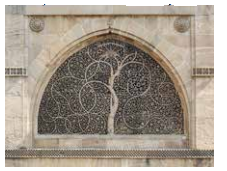
The rear wall is filled with square stone pierced panels in geometrical designs. The two bays flanking the central aisle have stone slabs carved in designs of intertwined trees and foliage and a palm motif.
Question 5.
Fatehpur Sikh
Answer:
After his military victories over Chittor and Ranthambore, Akbar decided to shift his capital from Agra to a new location, on the Sikri ridge, to honour the Sufi saint Salim Chishti. Here he commenced the construction of a planned walled city and constructed a series of royal palaces, courts, a mosque, private quarters and other utility buildings. He named the city, Fatehabad, with Fateh, meaning ‘victorious.’ it was later called Fatehpur Sikri. Fatehpur Sikri is one of the best-preserved collections of Mughal architecture in India.
Question 6.
Red Fort
Answer:
Red Fort
The Red Fort was built as the fortified family palace of Shahjahanabad, capital of the Mughal Emperor Shah Jahan.
The Red Fort is considered to represent the zenith of Mughal creativity under Shah Jahan and consists of other
important structures such as the Diwan-e-Aam, Diwan-e-Khas, Moti Masjid, Hayat Bakhsh Bagh and Rang Mahal.
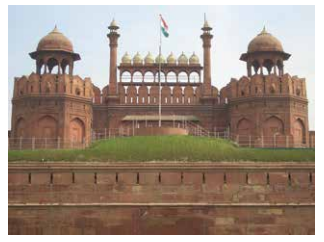
Question 7.
Taj Mahal
Answer:
Taj Mahal
The Taj Mahal is a white marble mausoleum located in Agra, Uttar Pradesh, India. It was built by Mughal
emperor Shah Jahan in memory of his third wife, Mumtaz Mahal. Taj Mahal is regarded as the finest example of Mughal architecture and is considered as one of the Seven Wonders of the World. The Taj Mahal is widely recognized as The jewel of Muslim art in India and one of the universally admired masterpieces of the world’s heritage.
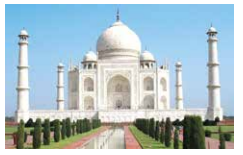
Masons, stonecutters, inlayers, carvers, painters, calligraphers, dome-builders and other artisans were requisitioned from the whole of the empire to work on the stwcture. The white marble has been polished to emphasise the exquisite detailing of the carvings and archways have been inlayed with semi-precious stones. Architecture was an emblem of power. Numerous outsiders invaded India and created architectural styles reflective of their ancestral and adopted homes. As a result, many artists got an opportunity to showcase their talent and skill. Hence, not only was their need for name and fame met, but they also earned a handsome livelihood.
The people, too, whatever the era, benefitted through such splendorous structures. Thus, we should be grateful to rulers and emperors who, in their quest for quenching the thirst towards creative excellence, motivated and inspired the subjects, generated a source of income and benefitted the society indirectly.
Things to know:
The town of Dwarka ¡s situated on the banks of river Gomti, which is to the western coast of Gujarat. Set up by Lord Shri Krishna, it is dedicated to Lord Krishna, who is worshipped here by the name of Dwarkadhish, or ‘King of Dwarka’. The Dwarkadhish temple is also known as the Jagat Mandir (World Temple).
Think:
Today there are roads to reach Badrinath, Kedarnath, Gangotri, Jamnotri etc. How did the people of old times go to such places?
Answer:
carts and by walks, they had horses for travel and if not horses Bullock carts were very prominent back then.
On the basis of the following itinerary, plan a tour for your school. (Use the map of Gujarat to plan for the tour)
Answer:
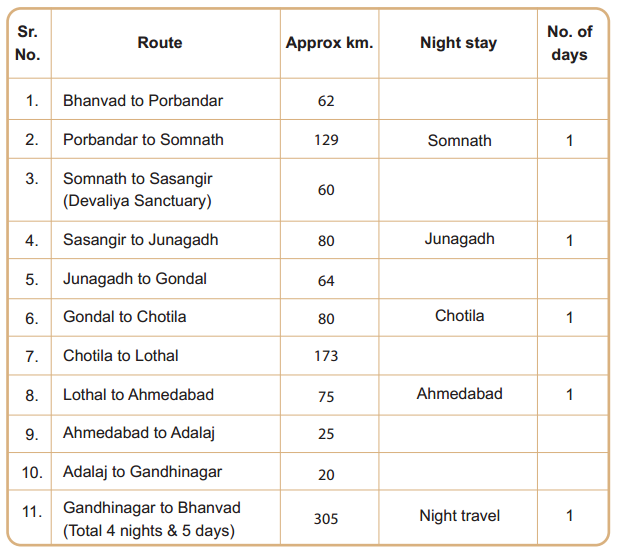
GSEB Class 7 Social Science Medieval Architecture Additional Questions and Answers
Question 1.
Explain what is architecture.
Answer:
Man carries out most of his activities either to earn money or gain happiness. Similarly, in the past, most of the kings and feudal lords indulged in various arts to gain happiness. The various arts they indulged into were literature, pictures, music, dance, painting as well as architecture. Kings constructed different structures to gain fame or satisfy the needs of their people.
The purpose behind building magnificent buildings was that others could utilize them and be happy. Such constructions are worth seeing. They also give us an idea of the lifestyle of the era in which they were built. With time, these properties do not remain private. They become public properties. The style in which a building is designed and constructed, especially with regard to a specific period, or culture is known as ‘architecture’.
Question 2.
Write a short note on the Sun Temple of Modhera.
Answer:
Sun Temple of Modhera :
A. Location:
The Sun Temple is located in Mahesana district of Gujarat.
It is located on the west of Tropic of Cancer and dedicated to Hindu Sun God, Surya.
It shares a special relation with the Sun Temple of Konark located in the eastern part of India.
B. Construction:
- The Sun Temple of Modhera was built in 1026-27 A.D. during the reign of King Bhimdev.
- In terms of carving and architecture, this temple holds a special position among the heritage temples of India.
- The temple is in octave shape.
- Its entrance has beautiful torans.
- The temple is located on a high platform.
- The temple can be divided into three parts: Garbhagruh (inner sanctum), Pradakshina Path and Sabha Mandapa (assembly hall).
- The Mandapa in the front of the Garbhagruh has 52 beautifully carved pillars.
- They represent the 52 weeks of the year.
- They depict the tales of Ramayana and Mahabharata.
- The entire temple has been carved minutely.
- The outer walls have been carved with beautiful paintings.
- The temple has been constructed in such a manner that the rays of the sun pass across the entire
- Sabhamandapa in the Sharad and Vasant months and fall directly on the Garbhagruh.
- There is a rectangular tank at the entrance of the temple.
- It is called Surya Kund.
- There are stone steps leading inside the tank.
- Among these steps are 108 miniature carved shrines.
- The Surya Kund is a beautiful sight in itself.
- The Sun Temple is a major centre of attraction for historians and architects.
- This is why the Sun Temple is considered as one of the best architectures of India.
- The Modhera Sun temple is similar in many aspects to the Konark Sun Temple which is situated on the east of the Tropic of Cancer.
Question 3.
Write a short note on Palitana.
Answer:
- Palitana, a big Jain pilgrimage centre, is located on the Shatrunjaya Hill, 51 to 60 km southwest from Bhavnagar.
- Palitana is one of the main pilgrim centres of the Jains.
- This place is the symbol of faith for Jains.
- Most Jains visit Palitana at least once in a lifetime.
- It is believed that the pilgrimage of Palitana is the way to attain nirvana for Jains.
- There are 863 temples on this hill.
- The main temple is dedicated to the first Jain Tirthankar (God) Lord Adinath, also called Rishabhdev. It is constructed with white marble.
- The main temple has ornamental architectural motifs.
- The interior of the temple is beautifully carved.
- The ceiling has geometrical lace designs.
- The overall construction of the temples of Palitana is very artistic.
- The carvings are very beautiful.
- These temples are so pious that they win the heart of the pilgrims.
- These temples were built with the help of Acharya Hemchandracharya, Siddhraj Jaysinh, Kumarpal and many other generations of Jains.
Question 4.
Write a note on Kankaria Lake.
Answer:
- Qutub-ud-din Aibak constructed a lake in Maninagar area of Ahmedabad during the Sultanate Age.
- The lake was called ‘Hauj-e-Qutub’ or ‘Qutub Hajj.
- Later, the lake became famous as Kankaria Lake.
- Today, Kankaria is a place of tourist interest due to its recreational activities like children’s gardens, a boat club, natural history museum, a zoo and numerous parks like the ‘Bal Vatika’.
Question 5.
Which type of buildings were constructed in Delhi during the Sultanate Age?
Answer:
- Very unique kind of construction was done in Delhi during the Sultanate Age.
- They were influenced by the Turkish culture.
- Thus, a new type of architecture called the Indo-Islamic style was born. The buildings were constructed by combining Indian, Arabic and Persian (Iranian) styles. Buildings were constructed by mixing lime powder and bricks. ,
- For the first time, arches, minarets and domes were constructed in buildings during the Sultanate Age.
- The buildings were decorated with lines, geometrical shapes, flowers, leaves and creepers and Indian motifs like lotus and bell.
Question 6.
Write a short note on Qutub Minar.
Answer:
- Qutub Minar is the tallest architectural monument of India.
- It is in Delhi.
- It is a five-storied building.
- The construction of Qutub Minar was started by Qutub-ud-din Aibak.
- However, it was completed by lltutmish.
- The minar is made of red sandstone.
- It is covered with intricate carvings and verses from the Quran.
Question 7.
Write a note on Bruhadeshwar temple.
Answer:
- The Bruhadeshwar temple also referred as Rajarajeshwar temple, is dedicated to Lord Shiva. It is in Tanjore.
- It has been built in Dravidian style.
- There are beautiful Chola Fresco paintings on the inner walls of the temple.
- The temple is a very unique one owing to its taller gopuram and smaller vimana as compared to other temples.
Question 8.
What kind of architecture was done in the Chola period?
Answer:
- The Cholas who ruled over south India were great lovers of art and architecture.
- They built many temples at Tanjore, Mahabalipuram (Mamallapuram) and Kanchi.
- The Cholas carried out the construction work in Dravid style.
- The Cholas built huge temples on high plinths, which were supported by divided planes, mandapa, and numerous pillars.
- The temples were built in a multi-storeyed pyramid tower type structure called the ‘vimana’.
- The interior of the temple had an assembly hall with lots of pillars called ‘mandapa’.
- The inner sanctum where the main deity was kept was called Garbhagruh.
- The temples had huge artistic entrance gates which were known as Gopurams.
- The campus of the temples was covered with high walls.
Question 9.
What kind of architecture was built in the Mughal period?
Answer:
- Mughals were very fond of grand architecture.
- They had their own unique tradition of architecture.
- They constructed palaces on high plinths.
- They used flowing water in the form of fountains in their building.
- Most of the Mughal architecture was made out of marble and decorated with precious and semi-precious coloured stones.
Question 11.
Write a short note on Buland Darwaza.
Answer:
- Buland Darwaza was built by Mughal Emperor Akbar at Fatehpur Sikri.
- It is a victory arch that symbolises Akbar’s conquer of Gujarat.
- The Buland Darwaza is on the south wall of Jama Masjid at Fatehpur Sikri.
- It is 55 m high.
- It has lots of pillars and ‘chhatris’ (carved umbrella type structures).
- It is clearly influenced by early Mughal architecture.
- The gate is not very ornamental but it has carved verses from the Quran and magnificent arches.
- Buland Darwaza is one of the most famous Islamic structures of Fatehpur Sikri.
Answer in one or two sentence(s)
[Note: Here, answers are given in short for memorizing easily. Students must write full sentences.]
Question 1.
What is architecture?
Answer:
The style in which a building is designed and constructed, especially with regard to a specific period, or culture is known as architecture.
Question 2.
Why is Somnath an important centre?
Answer:
Because it is the oldest and most prosperous temple of Shaivism.
Question 3.
Whose kiol is found in the Dwarkadhish Temple?
Answer:
Four-armed idol of Lord Krishna.
Question 4.
Where is the Sun Temple located in Gujarat?
Answer:
Near Modhera in Mahesana district on the west of Tropic of Cancer.
Question 5.
Into how many parts can the Sun Temple of Modhera be divided? Which are they?
Answer:
Three; Garbhagruh, Pradakshina Path and Sabha Mandapa
Question 6.
What is the unique feature of the Sun Temple of Modhera?
Answer:
The rays of the sun pass across the entire SabhaMandapa and fall on the Garbhagruh. in Sharad and Vasant months.
Question 7.
Where are the Jam temples of Palitana located?
Answer:
On the Shatrunjaya Hill, 51 to 60 km away from Bhavnagar.
Question 8.
Where is the Sidi Saiyyed Jali?
Answer:
Near Lai Darwaza in Ahmedabad.
Question 9.
Who built the Qutub Minar?
Answer:
Started by Qutub-ud-din Aibak and completed by iltutmish.
Question 10.
Where did the Cholas construct temples?
Answer:
Tanjore, Mahabalipuram (Mamallapuram) and Kanchi.
Question 11.
What are Gopurams?
Answer:
High artistic entrance gates of temples.
Question 12.
Which is the best example of the Dravid style construction?
Answer:
Bruhadeshwar temple
Question 13.
To whom is the Bruhadeshwar temple dedicated?
Answer:
Lord Shiva
Question 14.
Which are the important constructions of the Red Fort?
Answer:
Diwan-e-Aam, Moti Masjid, Diwan-e-Khaas, Rang Mahal and Hayaat Baksh Bagh.
Question 15.
Why did kings build huge monuments?
Answer:
A. Benefit society,
B. Earn personal fame,
C. Meet financial needs of workers,
D. Motivate workers to showcase their skills.
Multiple Choice Questions
Question 1.
There are ……………………….. jyotirlingas in India.
(A) 12
(B) 9
(C) 6
(D) 15
Answer:
(A) 12
Question 2.
Somnath is in ………………………….. district.
(A) Surendranagar
(B) Porbandar
(C) Amreli
(D) Junagadh
Answer:
(D) Junagadh
Question 3.
The new Somnath Temple was constructed in ……………………. .
(A) 1941
(B) 1951
(C) 1960
(D) 1971
Answer:
(B) 1951
Question 4.
There are ………………………… Haridham pilgrim centres in India.
(A) 4
(B) 8
(C) 12
(D) 16
Answer:
(A) 4
Question 5.
Dwarkadish temple is located on the banks of river …………………… .
(A) Mahi
(B) Vishwamitri
(C) Gomati
(D) Sabarmati
Answer:
(C) Gomati
Question 6.
The Dwarkadish temple was constructed in the ……………………………….. th century.
(A) 10
(B) 12
(C) 13
(D) 16
Answer:
(C) 13
Question 7.
The city of Dwarka was established by Lord …………………….. .
(A) Ganesha
(B) Shiva
(C) Krishna
(D) Vishnu
Answer:
(C) Krishna
Question 8.
The Sun Temple of Modhera is located on the …………………………. .
(A) Tropic of Cancer
(B) Tropic of Capricorn
(C) Equator
(D) Arctic Circle.
Answer:
(A) Tropic of Cancer
Question 9.
Who constructed the Sun Temple of Modhera?
(A) Shrimad Shankaracharya
(B) Bhimdev I
(C) Siddhraj Jaysinh
(D) Guru Hemchandracharya
Answer:
(B) Bhimdev I
Question 10.
The mandapa of the Sun temple of Modhera has been supported by ………………………….. pillars.
(A) 31
(B) 52
(C) 108
(D) 365
Answer:
(B) 52
Question 11.
Who started the construction of Rudra Mahalaya?
(A) Siddhraj Jaysinh
(B) Mulraj Solanki
(C) Kumarpal
(D) Bhimdev I
Answer:
(B) Mulraj Solanki
Question 12.
Palitana is the main pilgrim centre for ……………………. .
(A) Buddhists
(B) Sikhs
(C) Jains
(D) Muslims
Answer:
(C) Jains
Question 13.
There are ………………………… temples on Shatrunjaya hill.
(A) 836
(B) 863
(C) 848
(D) 884
Answer:
(B) 863
Question 14.
Shatrunjaya is the pilgrim place of Lord ………………………. .
(A) Adinath
(B) Neminath
(C) Parshwanath
(D) Mahavir Swami
Answer:
(A) Adinath
Question 15.
…………………… is known as Jagat Mandir.
(A) Sun Temple
(B) Somnath Temple
(C) Dwarkadhish Temple
(D) Shatrunjaya Jain Mandir
Answer:
(C) Dwarkadhish Temple
Question 16.
Who contributed in the making of the Jain temples of Palitana?
(A) Hemchandracharya
(B) Siddhraj Jaysinh
(C) Kumarpal
(D) All of these
Answer:
(D) All of these
Question 17.
Sidi Saiyyed Jali was built by a ………………. .
(A) Commander-in-chief
(B) General
(C) King
(D) Queen
Answer:
(B) General
Question 18.
Kankaria Lake was built during the ……………………. Age.
(A) Mughal
(B) Sultanate
(C) Maratha
(D) Rajput
Answer:
(B) Sultanate
Question 19.
The buildings built during the Sultanate Age in Delhi were constructed by combining ……………………… and ………………… style.
(A) German, Irish
(B) Indian, Iranian
(C) Turkish, Rajput
(D) Afghani, Mughal
Answer:
(B) Indian, Iranian
Question 20.
The tallest architectural monument of India is ……………………… .
(A) Qutub Minar
(B) Char Minar
(C) Julta Minar
(D) Buland Darwaza
Answer:
(A) Qutub Minar
Question 21.
There is/are ………………………. Gopuram(s) in the Bruhadeshwar Temple.
(A) 1
(B) 2
(C) 4
(D) 8
Answer:
(B) 2
Question 22.
The Mughals ………………………. (Select the incorrect option)
(A) Built huge Gopurams
(B) Decorated buildings with coloured stones
(C) Used flowing water in buildings
(D) Constructed palaces on high plinths
Answer:
(A) Built huge Gopurams
Question 23.
Fatehpur Sikri was set up by …………………… .
(A) Akbar
(B) Shah Jahan
(C) Aurangzeb
(D) Jahangir
Answer:
(A) Akbar
Question 24.
The most important building of the Fatehpur Sikri is ……………………… .
(A) Diwan-e-Aam
(B) Moti Masjid
(C) Diwan-e-Khaas
(D) Jama Masjid
Answer:
(D) Jama Masjid
Question 25.
The Red Fort was built by ………………… .
(A) Shah Jahan
(B) Akbar
(C) Humayun
(D) Aurangzeb
Answer:
(A) Shah Jahan
Question 26.
Panchmahal is a ………………………… storied building.
(A) 3
(B) 4
(C) 5
(D) 6
Answer:
(C) 5
Question 27.
Who was the wife of Shah Jahan?
(A) Nurjahan
(B) Hazrat Mahal
(C) Noor Begum
(D) Mumtaz Mahal
Answer:
(D) Mumtaz Mahal
Question 28.
…………………… is one of the seven wonders of the world.
(A) Red Fort
(B) Fatehpur Sikri
(C) Taj Mahal
(D) Qutub Minar
Answer:
(C) Taj Mahal
Question 29.
Bruhadeshwar Temple is in ……………………. .
(A) Mudumalai
(B) Trivandrum
(C) Khajuraho
(D) Tanjavur
Answer:
(D) Tanjavur
Question 30.
Who built Kankaria?
(A) Sidi Saiyyed
(B) Shams-ud-Din Muzzaffarshah III
(C) Qutub-ud-din Aibak
(D) lltutmish
Answer:
(C) Qutub-ud-din Aibak
Fill in the blanks
Question 1.
Somnath is an important centre of …………………. religion.
Answer:
Shaivism
Question 2.
Dwarka is in ………………………… district.
Answer:
Jamnagar
Question 3.
There are …………………………. steps in the Dwarkadhish Temple.
Answer:
80
Question 4.
There are ……………………… pillars in the Dwarkadhish Tern pie.
Answer:
600
Question 5.
The Sun Temple of Modhera was built in the year ……………… .
Answer:
10227
Question 6.
……………………. completed the work of Rudra Mahalaya.
Answer:
Siddhraj Jaysinh
Question 7.
There are ………………….. Jyotirlinga shrines in India.
Answer:
12
Question 8.
Lord Adinath is also called ………………… .
Answer:
Rishabhdev
Question 9.
Sidi Saiyyed was the general of the army of ………………………… .
Answer:
Shams-ud-Din Muzzaffarshah III
Question 10.
Kankaria was originally called ……………………. .
Answer:
Hauj-e-Qutub
Question 11.
Qutub Minar is in ……………………..
Answer:
New Delhi
Question 12.
……………………… was the first mosque of India.
Answer:
Dhai Din ka Jhopda
Question 13.
The Cholas built monuments in ……………………. style.
Answer:
Dravid
Question 14.
Bruhadeshwar Temple is also called …………….. temple.
Answer:
Rajeshwar
Question 15.
Most of the Mughal buildings were made of …………………….. .
Answer:
Marble
Question 16.
The south gate of Jama Masjid’s entrance is called ……………………. .
Answer:
Buland Darwaza
Question 17.
The Buland Darwaza is ……………………. m high.
Answer:
55
Question 18.
The Taj Mahal was built by …………………….. .
Answer:
Shah Jahan
Question 19.
The Taj Mahal is made of ……………………. .
Answer:
white marble
Question 20.
The Bruhadeshwar Temple was built during the ………………… period.
Answer:
Chola
True or False
Question 1.
Art was the most important form of entertainment for the kings.
Answer:
True
Question 2.
Jyotirlinga is a Shiva temple.
Answer:
True
Question 3.
Dwarkadish temple = Jagat Mandir = Temple of the world.
Answer:
True
Question 4.
Mahamandap refers to a prayer hall.
Answer:
True
Question 5.
Dwarkadhish Temple is also a matha.
Answer:
True
Question 6.
The sun temple located in Mehsana district lies on the east of the Tropic of cancer.
Answer:
False
Question 7.
Both, the sun temple of Modhera and that of Konark lie on the western part of India.
Answer:
False
Question 8.
King Bhimdev built the Sun temple of Modhera.
Answer:
True
Question 9.
Rudra Mahalaya was a famous king who built a few very famous temples of South India.
Answer:
False
Question 10.
Rudra = Shiva
Answer:
True
Question 11.
The main temple of Palitana is dedicated to Rishabhdev.
Answer:
True
Question 12.
Sidi Saiyyed jali was constructed by Ahmed Shah, the founder of Ahmedabad city.
Answer:
False
Question 13.
Kankariya Lake was once called ‘Hauj-e-Qutub’.
Answer:
True
Question 14.
Without lltutmish, we could not have got Qutub Minar.
Answer:
True
Question 15.
Taller gopuram and smaller vimana makes Bruhadeshwar Temple quite unique.
Answer:
True
Question 16.
Buland Darwaza is in Fatehpur Sikri.
Answer:
True
Match the following
(Note: You may choose an option more than once.)
| A | B |
| 1. Dwarka | a. Qutub-ud-din Aibak |
| 2. Sun Temple | b. Siddhraj Jaysinh |
| 3. Rudra Mahalaya | c. Sidi Saiyyed |
| 4. Palitana | d. Lord Krishna |
| 5. Kankaria Lake | e. Rajaraj |
| 6. Qutub Minar | f. Bhimdev I |
| 7. Dhai Din Ka Jhopda | g. Shams-ud-Din Muzzaffarshah |
| 8. Bruhadeshwar Temple | h. Akbar |
| 9. Fatehpur Sikri | i. Mumtaz Mahal |
| 10. Red Fort | j- Shah Jahan |
| k. Humayun |
Answer:
1-d 2-f 3-b 4-b 5-a 6-a 7-a 8-e 9-h 10-j